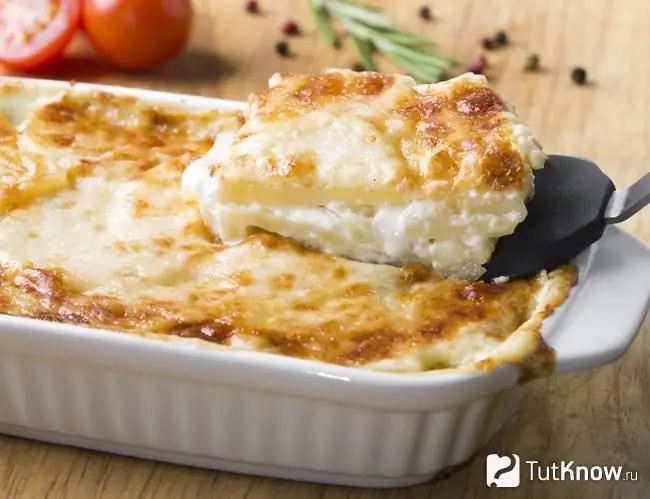A detailed review of Double Gloucester cheese: chemical composition, nutritional value, benefits and harms. How cheese is eaten, recipes with its participation.
Double Gloucester is a hard cheese with a bright yellow flesh, pleasant creamy aroma and small holes, which is made from unpasteurized cow's milk in various regions of the UK. Gloucester's nutty flavor is similar in many ways to Cheddar cheese. The product has beneficial properties for human health, but it is recommended to use it in small quantities. Next, let's take a closer look at the composition of the product and its properties.
How is Double Gloucester cheese made?

The British learned how to make Double Gloucester cheese back in the 16th century. At the time, the product was made from sheep milk by a single farm located in Gloucester. Over time, the cheese recipe changed, cow's milk was used to make the product, due to which the cheese pulp acquired a more uniform structure. They also decided to add paint to the cheese, thanks to which the product acquired a bright yellow color. Subsequently, Double Gloucester began to be recognized precisely by the bright color of the pulp.
The cheese makers decided to use food coloring not by chance, but to increase the demand for cheese. In ancient times, cow's milk in County Gloucester had a reddish tint. This was due to the fact that it contained a large amount of carotene. The cheese made from this milk also had a special color, which attracted the attention of buyers. In winter, the diet of local cows changed dramatically, they ate hay, and their milk became the usual white color. The cheese was pale and inconspicuous in winter. That is why cheesemakers decided to add a bright annatto dye to the cheese mass. The tradition of "touching up" Gloucester has survived into modern times.
The active phases in the production of the Double Gloucester variety: the formation of the curd - 3, 5 hours, the separation of the whey - 15 minutes. Passive stages: pressing - 1 day, drying of heads - up to 5 days, maturation - at least 2 months and maximum 9-10 months. Since dairy factories use fatty but pasteurized milk to make Double Gloucester cheese, calcium chloride is added.
Stages of making Double Gloucester:
- The feedstock is heated to 32 ° C, the starter culture is added - thermophilic lactic acid and mesophilic gas-forming bacteria. Close the lid and leave for 15-45 minutes to activate the flora.
- Then rennet is poured in, annatto dye is poured in, stir and wait until a dense clot is formed - kale. This process usually takes 45 minutes. Cutting cheese grains is violated after checking for a clean break.
- The curd curd is crushed with a "harp" into small cubes with sides of 0.6 cm. Allow to stand for the whey to stand out and, slowly warming up to 40 ° C, (1 ° C / min.), Knead for about half an hour.
- Separate pieces are allowed to settle, the whey is drained almost to the surface of the curd layer. For a short time, very slowly, shake everything - from top to bottom, and then transfer the cheese mass to the drainage table.
- When making Double Gloucester cheese, no moisture is expected to separate completely. Pour in salt - half of the prepared portion (for 10 liters of raw materials - 2 tbsp. L.). Stir and leave for 10 minutes. Pre-salting speeds up the separation of the whey.
- The form is covered with muslin or other drainage fabric of rare weaving, filled with cheese grains, compacted as necessary so that there are no voids left. Oppression is installed on top. The weight of the load for pressing Double Gloucester cheese is calculated as follows (for 1.5 kg of cheese): 15 minutes - 4.5 kg, 10 minutes - 13.5 kg, 2 hours - 18 kg.
- Then the head is wrapped with a clean dry cloth and placed under oppression weighing 22.5 kg per day. Turn over every 6 hours.
- Leave the cheese on a drainage table at room temperature - the exposure time is determined empirically. As soon as the surface becomes dry to the touch, the head is placed in a chamber with a temperature of 12-14 ° C and a relatively low humidity of 80-83%.
As a result, the cheese is round in shape, with a salty taste. The longer the Double Gloucester is aged, the richer its salty flavor will be.
Many people have a question, if there is a double Gloucester, then there is also a single one? Cheese makers actually make 2 types of Gloucester. The difference between the two lies in the fat content of the milk. For a single Gloucester, milk is used that has passed the skimming process. Whole milk is also added to the cheese, but in small quantities. Double type of cheese is prepared only from whole fat milk. It is Double Gloucester that has, as gourmets assure, a more persistent taste and is most often exported. It also matures in special boxes longer than its counterpart from fat-free raw materials.
Composition and calorie content of Double Gloucester cheese

The composition of Double Gloucester cheese contains a small amount of ingredients: fatty cow's milk, natural food coloring, which is extracted from the seeds of the tropical annatto tree, table salt and an enzyme for fermenting milk.
The calorie content of Double Gloucester cheese per 100 g is 405 kcal, of which:
- Proteins - 24.5 g;
- Fat - 34 g;
- Carbohydrates - 0.1 g.
Vitamins per 100 g of product:
- Vitamin A - 378 mg;
- Vitamin B1, thiamine - 0.03 mg;
- Vitamin B2, riboflavn - 0.45 mg;
- Vitamin B3, niacin - 0.1 mg;
- Vitamin B4, choline - 15.4 mg;
- Vitamin B5, pantothenic acid - 0, 11 mg;
- Vitamin B6 - 0, 11 mg;
- Vitamin B7, biotin - 3.1 mg;
- Vitamin B9, folate - 30 mcg;
- Vitamin B12 - 1.3 mg;
- Vitamin D - 0.3 mcg;
- Vitamin E - 0.54 mg.
Macro- and microelements in 100 g of Double Gloucester cheese:
- Iodine, I - 46 mg;
- Potassium, K - 79 mg;
- Zinc, Zn - 1.8 mg;
- Selenium, Se - 12 μg;
- Iron, Fe - 0.4 mg;
- Copper, Cu - 0.03 mg;
- Magnesium, Mg - 23 mg;
- Phosphorus, P - 460 mg;
- Calcium, Ca - 660 mg.
The fat content of Gloucester is approximately 45%.
Benefits of Double Gloucester Cheese

The benefit of Double Gloucester cheese lies in its diverse chemical composition: the product is rich in both vitamins and minerals with amino acids. From a few bites of Gloucester, you can get an adult's daily nutrient requirement.
Double Gloucester cheese is made from cow's milk, which means that it enriches the body with calcium. This element has a beneficial effect on the condition of the musculoskeletal system.
One of the main advantages of Double Gloucester is its beneficial effect on the nervous system. It is known that a person receives substances from milk that have a weak sedative effect. These opiates can help lift a person's mood, even under stress. That is why dairy products are recommended to be consumed in the evening, in which case they provide a long and sound sleep. Vitamins of group B also have a beneficial effect on the central nervous system, of which there are several types in Double Gloucester at the same time.
Other useful properties of the product:
- Improving skin condition - vitamin E takes part in this process. Thanks to this, the use of Double Gloucester in reasonable quantities can lead to a significant improvement in a person's appearance, his skin will acquire a healthy color and become smooth.
- Prevention of the development of bone tissue diseases - the product contains vitamin D, which is necessary for a person to increase bone strength.
- Improving effects on the visual system - Double Gloucester cheese improves eyesight thanks to vitamin A.
- Energizes - amino acids are involved in this process, of which there are a lot of Double Gloucester. A few slices of cheese will help to quickly satisfy hunger and restore strength. That is why the product is recommended for use by athletes and people who experience heavy physical exertion. Also, amino acids are involved in the synthesis of hormones.
On a note! It is recommended to store Double Gloucester cheese in special waxed paper. Such packaging will protect the product from the accumulation of excess moisture and absorption of odors without isolating oxygen - hard cheese needs contact with a small amount of air, only in this case it can be stored for a long time without losing its taste.
Contraindications and harm of Double Gloucester cheese

The harm of Double Gloucester cheese is explained by its high percentage of fat, high content of salt, lactose and casein.
The product is made from unpasteurized fatty raw materials, so it is quite easy to recover from it. Nutritionists recommend giving up cheese to anyone who is struggling with excess weight or high blood cholesterol. If you cannot refuse hard cheese, eat it in limited quantities and prefer Single Gloucester rather than Double.
100 g of Double Gloucester contains 1.7 g of salt. If you regularly eat cheese in large quantities, excess salt can accumulate in the body, which leads to the following negative consequences:
- accumulation of excess fluid in the body;
- the development of joint diseases;
- deterioration in appearance.
Remember, as excess fluid builds up, your body weight will increase as well. This will entail the appearance of venous diseases and other negative consequences.
Lactose is a kind of milk sugar, while casein is a type of protein found in cow's milk. Many people are diagnosed with an allergy to one, and sometimes two of these substances at the same time. Therefore, Double Gloucester should not be eaten by people suffering from individual intolerance to cow's milk.
Pediatricians forbid giving cheese to young children. The product has a high calorie content. Therefore, it can negatively affect the state of the liver and the human gastrointestinal tract.
Also, people with acute diseases of the gastrointestinal tract should refuse Gloucester.
Doctors say Double Gloucester can be safe for health if consumed in reasonable amounts.
Double Gloucester Cheese Recipes

Double Gloucester is versatile to use. It can be added to any food that requires hard cheese. The product is grated, grilled, added to casseroles, snacks and sauces. Double Gloucester goes well with almost any alcoholic beverage. In his homeland, it is customary to serve cheese with ale, as well as white and red wine.
Simple recipes to cook with Double Gloucester in your home kitchen:
- Cheese in pots … To prepare this dish, you will have to spend time looking for three types of cheese: Bubble Gloucester (75 g), Derby (50 g) and Blue Wensleydale blue cheese (75 g). Grate all types of cheese on a fine grater. To the resulting mass, add 110 g of butter, 40 ml of dry sherry (a kind of strong wine), a pinch of nutmeg and dry mustard. Season the dish with salt and ground black pepper to your taste. Stir the ingredients thoroughly and divide the mixture into the baking pots. Leave the cheese mass in the preheated oven for a few minutes, until it becomes thin and stringy. Allow the dish to cool slightly before serving.
- Burger "Gloucester" … This dish will take no more than 15-20 minutes to cook. The degree of difficulty is easy. Start by making a meatball by mixing 170g ground beef with a few pinches of salt. Shape the cutlet from the mixture so that its thickness is about 2 cm. Make a small depression in the center of the cutlet. Preheat a frying pan, preferably made of cast iron (this is necessary so that the meat does not stick, because we do not use oil to fry it). Sprinkle salt on the hot surface and place the cutlet on it. It is necessary to fry the meat for 4 minutes on each side. Place the cooked patty on a lightly toasted muffin bun. Place 2 thick Double Gloucester slices on top of the hot patty. Bon Appetit!
- Potato casserole with cheese … Peel 1 kg of potatoes and place them in cold water (if not, the tubers will darken). Dry the potatoes and chop them into small slices. This can be done using a sharp knife or a special shredder grater. Also grate 150 g Double Gloucester and a couple of garlic cloves (to your taste). Prepare a baking dish: brush it with butter. Place some of the potatoes on the bottom of the mold. Try to overlap the pieces so that they resemble fish scales. Sprinkle some of the cheese and garlic over the potato layer. Sprinkle the resulting crust with a pinch of nutmeg. Next, lay out the remaining ingredients in the same order, leaving some potatoes for the finishing layer. Sprinkle the last layer of potatoes with nutmeg. Now prepare the filling for the dish: mix 250 ml of cream with 150 ml of milk and a little salt. Pour the cooked sauce over the casserole and send the form to the oven for 40 minutes. The finished casserole should not be taken out of the oven immediately, it is advisable to leave it warm for another 10-15 minutes.
Advice from a professional chef! The casserole in the oven may start to burn on top due to too high a temperature. To prevent this from happening, the dish can be covered with foil.
Interesting facts about Double Gloucester cheese

Double Gloucester has a fairly rich history of existence. Over time, its recipe, popularity level and consumer audience have changed.
It was mentioned earlier that this type of cheese was not always made from cow's milk. Initially, milk of a certain type of sheep was used for its production. Such a product had an affordable cost and was in good demand among poor people.
However, cheese makers have come to the conclusion that cow's milk is more practical to use and gives the cheese a special flavor and color. So for Gloucester, they began to use the milk of cows and only one specific local breed. Under certain circumstances, in 1745, the population of these animals declined sharply, and there was a critical shortage of milk to make cheese. This led to the fact that Double Gloucester and completely stopped making and supplying for sale. However, cheese makers have kept the recipe for the product and the technology of its production.
Later, cheese production was resumed. Cheesemakers could not return to the previous sales volumes, because by that time a lot of other varieties of hard cheeses appeared on the grocery market, which had an affordable price. Double Gloucester is now in high demand again in the UK. Now it is made from the milk of cows of various breeds.
It is to this cheese that comic races in one of the regions of England are devoted to. The essence of the cheese race is as follows: the organizers of the event let Gloucester's cheese head down a steep and winding slope, and the competitors must catch the product until it reaches the so-called finish line. The total length of the distance along which the cheese rolls is 200 m. Both men and women can take part in such a race. Whoever catches the cheese head first wins. The organizers of the event donate several kilos of Gloucester to the winner of the race.
Not only adults, but also children can take part in such an entertaining cheese festival. For them, the conditions of the competition change slightly: the winner is the one who climbs the first to the top of the steep descent. The winner also gets Gloucester, but in smaller numbers.
Double Gloucester cheese is the basis for creating other types of cheese, for example, "Huntsman". It is enough to add dried leeks and chives to Gloucester to get the world-famous Cotswold cheese.
Watch the video about Double Gloucester cheese:

Double Gloucester is a fatty and aromatic cheese that will please any person. You don't have to be a gourmet to understand the full value of the taste of this product. Every hospitable housewife should have a slice of Gloucester in her refrigerator, because this cheese can easily make a delicious snack for a quick hand in case of an unexpected visit from friends or relatives.






